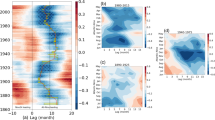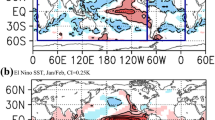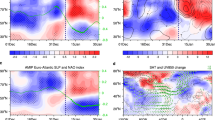Abstract
The teleconnection between the Atlantic Niño and the Pacific El Niño Southern Oscillation (ENSO) is revisited using observational and reanalysis data for the 1905–2014 period. Two types of Atlantic Niño are significantly negatively correlated with ENSO, with Atlantic leading ENSO by 6-month to 1-year. The first one is the already well-known connection between the boreal summer Atlantic Niño (ATL3: 3° N–3° S, 20° W–0°) and the subsequent winter ENSO (Niño3: 5° N–5° S, 150° W–90° W). This relationship is strong in the first and last decades of the study period. It is shown that a second Atlantic Niño in boreal fall/early winter (October–December, hereinafter called winter Atlantic Niño) is also significantly correlated with the following year ENSO. This winter Atlantic Niño leads to an early development of ENSO from boreal summer onwards, with a marked multidecadal modulation of the lead time. A nearly 1-year leading connection between winter Atlantic Niño and the following ENSO is generally observed in the mid-twentieth century, mostly when the summer Atlantic Niño teleconnection with the subsequent winter ENSO is weak. The same mechanism of the Atlantic–Pacific Niño connection, which involves the Walker circulation, operates for the two types of Atlantic Niño. Our analysis supports the leading influence of the summer and winter Atlantic equatorial modes on climate variability in South America. These results suggest the relevance of different types of Atlantic Niño for the 6-month to 1-year predictability of ENSO and its climatic impacts.







Similar content being viewed by others
Notes
All seasons indicated in this study are referred to boreal seasons.
References
Alexander MA, Blade I, Newman M, Lanzante JR, Lau NC, Scott JD (2002) The atmospheric bridge: the influence of ENSO teleconnections on air-sea interaction over the global oceans. J Clim 15(16):2205–2231
An SI, Wang B (2001) Mechanisms of locking of the El Niño and La Niña nature phases to boreal winter. J Clim 14:2164–2176
Ashok K, Behera S, Rao AS, Weng H, Yamagata T (2007) El Niño Modoki and its teleconnection. J Geophys Res 112:C11007. https://doi.org/10.1029/2006JC003798
Bjerknes J (1969) Atmospheric teleconnections from the equatorial Pacific. Mon Wea Rev 97:163–172
Blumenthal MB (1991) Predictability of a coupled atmosphere-ocean model. J Clim 4:766–784
Cai W et al (2019) Pantropical climate interactions. Science. https://doi.org/10.1126/science.aav4236
Cane MA (2005) The evolution of El Niño, past and future. Earth Planet Sci Lett 230:227–240
Caniaux G, Giordani H, Redelsperger J-L, Guichard F, Key E, Wade M (2011) Coupling between the Atlantic cold tongue and the West African monsoon in boreal spring and summer. J Geophys Res. https://doi.org/10.1029/2010JC00657
Chang P, Fang Y, Saravanan R, Ji L, Seidel H (2006) The cause of the fragile relationship between the Pacific El Ninño and the Atlantic Niño. Nature 443:324–328. https://doi.org/10.1038/nature05053
Chiang JC, Kushnir Y, Zebiak SE (2000) Interdecadal changes in eastern Pacific ITCZ variability and its influence on the Atlantic ITCZ. Geo Res Lett 27:3687–3690
Compo GP, Whitaker JS, Sardeshmukh PD et al (2011) The twentieth century reanalysis project. Q J R Meteor Soc 137:1–28
Delécluse P, Servain J, Levy C, Arpe K, Bengtsson L (1994) On the teleconnection between the 1984 Atlantic warm event and the 1982–1983 ENSO. Tellus 46A:448–464
Ding H, Keenlyside N, Latif M (2009) Seasonal cycle in the upper equatorial Atlantic Ocean. J Geophys Res 114(C9):C09016
Ding H, Keenlyside NS, Latif M (2012) Impact of the equatorial Atlantic on the El Nino southern oscillation. Clim Dyn 38:1965–1972. https://doi.org/10.1007/s00382-011-1097-y
Dong BW, Sutton RT, Scaife AA (2006) Multidecadal modulation of El Nino-Southern oscillation (ENSO) variance by Atlantic Ocean sea surface temperatures. Geophys Res Lett. https://doi.org/10.1029/2006GL025766
Enfield DB, Mayer DA (1997) Tropical Atlantic sea surface temperature variability and its relation to El Niño-Southern Oscillation. J Geophys Res 102:929–945
Foltz GR, McPhaden MJ (2010) Abrupt equatorial wave-induced cooling of the Atlantic cold tongue in 2009. Geophys Res Lett 37:L24605. https://doi.org/10.1029/2010GL045522
Frauen C, Dommenget D (2012) Influences of the tropical Indian and Atlantic Oceans on the predictability of ENSO. Geophys Res Lett 39:L02706. https://doi.org/10.1029/2011GL050520
Giannini A, Chiang JCH, Cane MA, Kushnir Y, Seager R (2001) The ENSO teleconnection to the tropical Atlantic Ocean: contributions of the remote and local SSTs to rainfall variability in the tropical Americas. J Clim 14:4530–4544
Giannini A, Saravanan R, Chang P (2004) The preconditioning role of tropical Atlantic variability in the development of the ENSO teleconnection: implications for the prediction of Nordeste rainfall. Clim Dyn 22:839–855
Giese BS, Seidel HF, Compo GP, Sardeshmukh PD (2016) An ensemble of ocean reanalyses for 1815–2013 with sparse observational input. J Geophys Res Oceans 121:6891–6910. https://doi.org/10.1002/2016JC012079
Grimm AM (2003) The El Niño impact on the summer monsoon in Brazil: regional processes versus remote influences. J Clim 16:263–280
Grimm AM, Tedeschi RG (2009) ENSO and extreme rainfall events in South America. J Clim 22:1589–1609
Grimm AM, Barros VR, Doyle ME (2000) Climate variability in southern South America associated with El Niño and La Nina events. J Clim 13:35–58
Ham YG, Kug JS, Park JY, Jin FF (2013) Sea surface temperature in the north tropical Atlantic as a trigger for El Niño/Southern oscillation events. Nat Geosci 6:112–116
Hounsou-Gbo GA, Servain J, Araujo M, Caniaux G, Bourlès B, Fontenele D, Martins ESPR (2019) SST indexes in the Tropical South Atlantic for forecasting rainy seasons in northeast Brazil. Atmosphere 10:335
Izumo T, Vialard J, Lengaigne M, de Boyer MC, Behera SK, Luo J-J (2010) Influence of the state of the Indian Ocean dipole on the following year’s El Niño. Nat Publ Group 3(3):168–172
Jia F, Cai WJ, Wu LX, Gan BL, Wang GJ, Kucharski F, Chang P, Keenlyside N (2019) Weakening Atlantic Niño-Pacific connection under greenhouse warming. Sci Adv 5(8):4111. https://doi.org/10.1126/sciadv.aax4111
Jin EK et al (2008) Current status of ENSO prediction skill in coupled ocean-atmosphere models. Clim Dyn 31:647–664. https://doi.org/10.1007/s00382-008-0397-3
Jouanno J, Hernandez O, Sanchez-Gomez E (2017) Equatorial Atlantic interannual variability and its relation to dynamic and thermodynamic processes. Earth Syst Dyn 8:1061–1069
Kayano MT, Andreoli RV (2006) Relationship between rainfall anomalies over northeastern Brazil and the El Niño-Southern Oscillation. J Geophys Res 111(D13):101
Kayano MT, Valéria Andreoli R, Ferreira de Souza RA (2011) Evolving anomalous SST patterns leading to ENSO extremes: relations between the tropical Pacific and Atlantic Oceans and the influence on the South American rainfall. Int J Climatol 31:1119–1134. https://doi.org/10.1002/joc.2135
Kayano MT, Andreoli RV, Ferreira de Souza RA (2012) Relations between ENSO and the South Atlantic SST modes and their effects on the South American rainfall. Int J Climatol 33(8):2008–2023. https://doi.org/10.1002/joc.3569
Keenlyside NS, Latif M (2007) Understanding equatorial Atlantic interannual variability. J Clim 20:131–142
Keenlyside NS, Ding H, Latif M (2013) Potential of equatorial Atlantic variability to enhance El Nino prediction. Geophys Res Lett 40:2278–2283. https://doi.org/10.1002/grl.50362
L’Heureux ML, Takahashi K, Watkins AB, Barnston AG, Becker EJ, Di Liberto TE, Gamble F, Gottschalck J, Halpert MS, Huang B, Mosquera-Vásquez K, Wittenberg AT (2017) Observing and predicting the 2015–2016 El Niño. Bull Am Meteorol Soc. https://doi.org/10.1175/BAMS-D-16-0009.1
Latif M, Barnett TP (1995) Interactions of the Tropical Oceans. J Clim 8:952–964
Losada T, Rodríguez-Fonseca B (2016) Tropical atmospheric response to decadal changes in the Atlantic equatorial mode. Clim Dyn 47:1211–1224. https://doi.org/10.1007/s00382-015-2897-2
Lübbecke JF, McPhaden MJ (2012) On the inconsistent relationship between Pacific and Atlantic Niños. J Clim 25:4294–4303. https://doi.org/10.1175/JCLI-D-11-00553.1
Lübbecke JF, McPhaden MJ (2017) Symmetry of the Atlantic Niño mode. Geophys Res Lett 44(2):965–973. https://doi.org/10.1002/2016GL071829
Lübbecke JF, Böning CW, Keenlyside NS, Xie S-P (2010) On the connection between Benguela and equatorial Nñios and the role of the South Atlantic anticyclone. J Geophys Res. https://doi.org/10.1029/2009JC005964
Lübbecke JF, Rodríguez-Fonseca B, Richter I, Martín-Rey M, Losada T, Polo I, Keenlyside NS (2018) Equatorial Atlantic variability—modes, mechanisms, and global teleconnections. Wiley Interdiscip Rev Climate Change 9(4):1–18. https://doi.org/10.1002/wcc.527
Lutz K, Rathmann J, Jacobeit J (2013) Classification of warm and cold water events in the eastern tropical Atlantic Ocean. Atmos Sci Lett 14:102–106
Marengo JA, Liebmann B, Grimm AM et al (2012) Recent developments on the South American monsoon system. Int J Climatol. https://doi.org/10.1002/joc.2254
Marin F, Caniaux G, Bourles B, Giordani H, Gouriou Y, Key E (2009) Why were sea surface temperatures so different in the eastern equatorial Atlantic in June 2005 and 2006? J Phys Oceanogr 39:1416–1431. https://doi.org/10.1175/2008jpo4030.1
Martín-Rey M, Rodríguez-Fonseca B, Polo I, Kucharski F (2014) On the Atlantic–Pacific Niños connection: a multidecadal modulated mode. Clim Dyn 43:3163–3178
Martín-Rey M, Rodríguez-Fonseca B, Polo I (2015) Atlantic opportunities for ENSO prediction. Geophys Res Lett 42:6802–6810
Martín-Rey M, Polo I, Rodriguez-Fonseca B, Losada T, Lazar A (2018) Is there evidence of changes in Tropical Atlantic variability modes under AMO phases in the observational record? J Clim 31:515–536. https://doi.org/10.1175/JCLI-D-16-0459.1
McPhaden MJ (2003) Tropical Pacific Ocean heat content variations and ENSO persistence barriers. Geophys Res Lett 30:1480. https://doi.org/10.1029/2003GL016872
McPhaden MJ, Zhang X (2009) Asymmetry in zonal phase propagation of ENSO sea surface temperature anomalies. Geophys Res Lett 36:L13703
Merle J (1983) Seasonal variability of subsurface thermal structure in the Tropical Atlantic Ocean. Elsevier Oceanogr Ser 36:31–49. https://doi.org/10.1016/s0422-9894(08)70626-3
Merle J, Fieux M, Hisard P (1980) Annual signal and interannual anomalies of sea surface temperature in the eastern equatorial Atlantic Ocean. Deep-Sea Res 26:77–101
Nnamchi HC, Li J, Kucharski F, Kang IS, Keenlyside NS, Chang P, Farneti R (2015) Thermodynamic controls of the Atlantic Niño. Nat Commun 6:8895. https://doi.org/10.1038/ncomms9895
Nobre P, Shukla J (1996) Variations of sea surface temperature, wind stress, and rainfall over the tropical Atlantic and South America. J Clim 9:2464–2479
Okumura YM, Deser C (2010) Asymmetry in the duration of El Nino and La Nina. J Clim 23:5826–5843
Okumura Y, Xie S-P (2006) Some overlooked features of tropical Atlantic climate leading to a new Nino-like phenomenon. J Clim 19:5859–5874
Park JH, Li T (2019) Interdecadal modulation of El Niño–tropical North Atlantic teleconnection by the Atlantic multi-decadal oscillation. Clim Dyn 52:5345–5360. https://doi.org/10.1007/s00382-018-4452-4
Picaut J (1983) Propagation of seasonal coastal upwelling in the eastern equatorial Atlantic. J Phys Oceanogr 13:18–37
Polo I, Lazar A, Rodriguez-Fonseca B, Mignot J (2015b) Growth and decay of the equatorial Atlantic SST mode by means of closed heat budget in a coupled general circulation model. Front Earth Sci 3:37. https://doi.org/10.3389/feart.2015.00037
Polo I, Martin-Rey M, Rodriguez-Fonseca B, Kucharski F, Mechoso CR (2015a) Processes in the Pacific La Nina onset triggered by the Atlantic Nino. Clim Dyn 44:115–131. https://doi.org/10.1007/s00382-014-2354-7
Rayner NA, Parker DE, Horton EB, Folland CK, Alexander LV, Rowell DP, Kent EC, Kaplan A (2003) Global analyses of sea surface temperature, sea ice, and night marine air temperature since the late nineteenth century. J Geophys Res Atm 108(D14):4407. https://doi.org/10.1029/2002JD002670
Ren H-L, Jin F-F, Tian B et al (2016) Distinct persistence barriers in two types of ENSO. Geophys Res Lett 43:10973–10979
Richter I (2015) Climate model biases in the eastern tropical oceans: causes, impacts and ways forward. WIRE Clim Change 6:345–358. https://doi.org/10.1002/wcc.338
Richter I, Behera SK, Masumoto Y, Taguchi B, Sasaki H, Yamagata T (2013) Multiple causes of interannual sea surface temperature variability in the equatorial Atlantic Ocean. Nat Geosci 6(1):43–47. https://doi.org/10.1038/Ngeo1660
Rodrigues RR, McPhaden MJ (2014) Why did the 2011–2012 La Niña cause a severe drought in the Brazilian Northeast? Geophys Res Lett 41:1012–1018. https://doi.org/10.1002/2013GL058703
Rodrigues RR, Campos EJD, Haarsma R (2015) The impact of ENSO on the South Atlantic subtropical dipole mode. J Clim 28(7):2691–2705. https://doi.org/10.1175/JCLI-D-14-00483.1
Rodriguez-Fonseca B, Polo I, Garcia-Serrano J, Losada T, Mohino E, Mechoso CR, Kucharski F (2009) Are Atlantic Ninos enhancing Pacific ENSO events in recent decades? Geophys Res Lett 36:L20705. https://doi.org/10.1029/2009GL040048
Santoso A, Mcphaden MJ, Cai W (2017) The defining characteristics of ENSO extremes and the strong 2015/2016 El Niño: ENSO extremes. Rev Geophys 55(4):1079–1129. https://doi.org/10.1002/2017RG000560
Schneider U, Becker A, Finger P, Meyer-Christoffer A, Ziese M, Rudolf B (2013) GPCC’s new land surface precipitation climatology based on quality-controlled in situ data and its role in quantifying the global water cycle. Theor Appl Climatol 115:15–40
Servain J, Picaut J, Merle J (1982) Evidence of remote forcing in the equatorial Atlantic Ocean. J Phys Oceanogr 12:457–463
Servain J, Busalacchi A, McPhaden M, Moura A-D, Reverdin G, Vianna M, Zebiak S (1998) A pilot research moored array in the tropical Atlantic (PIRATA). Bull Am Meteor Soc 79:2019–2031
Servain J, Wainer I, McCreary JP, Dessier A (1999) Relationship between the equatorial and meridional modes of climatic variability in the tropical Atlantic. Geophys Res Lett 26:485–488
Tedeschi RG, Cavalcanti IFA, Grimm AM (2012) Influences of two types of ENSO on South American precipitation. Int J Climatol 33:1382–1400
Tokinaga H, Richter I, Kosaka Y (2019) ENSO influence on the Atlantic Niño, revisited: Multi-year versus single-year ENSO events. J Clim 32:4585–4600
Torrence C, Webster PJ (1998) The annual cycle of persistence in the El Niño/Southern Oscillation. Q J R Meteor Soc 124:1985–2004
Trenberth KE (1997) The definition of El Niño. Bull Am Meteor Soc 78:2771–2777
Uvo CB, Repelli CA, Zebiak SE, Kushnir Y (1998) The relationship between tropical Pacific and Atlantic SST and northeast Brazil monthly precipitation. J Clim 11:551–562
Wang C (2019) Three-ocean interactions and climate variability: a review and perspective. Clim Dyn 53:5119–5136. https://doi.org/10.1007/s00382-019-04930-x
Wauthy B (1983) Introduction à la climatologie du Golfe de Guinée. Océanogr Trop 18(2):103–138
Wolter K, Timlin MS (1998) Measuring the strength of ENSO events—how does 1997/98 rank? Weather 53:315–324. https://doi.org/10.1002/j.1477-8696.1998.tb06408.x
Wu X, Okumura YM, DiNezio PN (2019) What controls the duration of El Niño and La Niña events? J Climate 32:5941–5965. https://doi.org/10.1175/JCLID-18-0681.1
Yu J-Y, Lau KM (2005) Contrasting Indian Ocean SST variability with and without ENSO influence: a coupled atmosphere-ocean GCM study. Meteorol Atmos Phys 90:179–191. https://doi.org/10.1007/s00703-004-0094-7
Zebiak SE (1993) Air–sea interaction in the equatorial Atlantic region. J Clim 6:1567–1586
Zebiak SE, Cane MA (1987) A model El Niño Southern Oscillation. Mon Wea Rev 115:2262–2278
Acknowledgements
This study is a component of the project “Elaboração de Estudos de Suporte ao Planejamento e à Gestão de Sistemas Hídricos no Nordeste, com foco no Abastecimento Urbano e na Operação de Infraestruturas Hídricas de Uso Múltiplo” (Grant 001/2016 ANA/FUNCEME SICONV 863.189/2016). J. S. thanks FUNCEME (Edital 01/2016) for its support at Fortaleza, CE, Brazil. This work also represents collaboration by the INCT AmbTropic, the Brazilian National Institute of Science and Technology for Tropical Marine Environments, CNPq/FAPESB (grants 565054/2010-4 and 8936/2011 and 465634/2014-1) and the Brazilian Research Network on Global Climate Change FINEP/Rede CLIMA (grants 01.13.0353-00). This is a contribution to the LMI-TAPIOCA and to the TRIATLAS project, which has received funding from the European Union’s Horizon 2020 research and innovation program under grant agreement No 817578. We acknowledge Met Office Hadley Centre observations datasets (https://www.metoffice.gov.uk/hadobs/) for HadISST and EN.4.2.1 dataset. The 20th Century Reanalysis V3 data are provided by the NOAA/OAR/ESRL PSD, Boulder, Colorado, USA, from their Web site at https://www.esrl.noaa.gov/psd/. GPCC Precipitation data are provided by the NOAA/OAR/ESRL PSD, Boulder, Colorado, USA, from their Web site at https://www.esrl.noaa.gov/psd/.
Author information
Authors and Affiliations
Corresponding author
Ethics declarations
Conflict of interest
The authors declare that there is no conflict of interest regarding the publication of this paper.
Additional information
Publisher's Note
Springer Nature remains neutral with regard to jurisdictional claims in published maps and institutional affiliations.
Rights and permissions
About this article
Cite this article
Hounsou-Gbo, A., Servain, J., Vasconcelos Junior, F.C. et al. Summer and winter Atlantic Niño: connections with ENSO and implications. Clim Dyn 55, 2939–2956 (2020). https://doi.org/10.1007/s00382-020-05424-x
Received:
Accepted:
Published:
Issue Date:
DOI: https://doi.org/10.1007/s00382-020-05424-x




